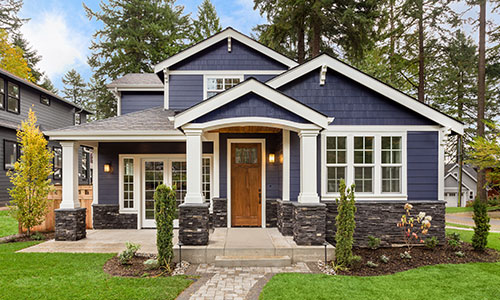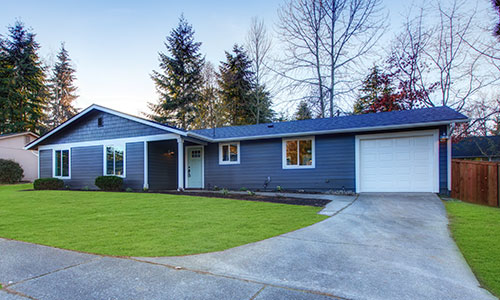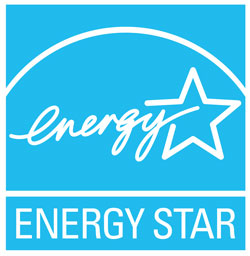Each section below includes a brief overview of the applicable programs and a wealth of resources for using foam plastic insulating sheathing continuous insulation to achieve a variety of financial incentives for energy efficient construction.
New Residential Construction

The 2022 Inflation Reduction Act (IRA) amended Internal Revenue Code Section 45L, Tax Credit for Energy Efficient New Homes, to provide taxpayers with a tax credit for eligible new or substantially reconstructed homes that meet applicable ENERGY STAR home program or DOE Zero Energy Ready Home (ZERH) program requirements. In 2025, the One Big Beautiful Bill Act (Public Law 119-21) changed the termination date of the 45L tax credit from December 31, 2032, to June 30, 2026.
The 45L provisions include two tiers of credits – $2500 or $5000 – with the higher credits for eligible homes and dwelling units certified to applicable ZERH program requirements. The qualified contractor – typically the developer, builder or homeowner – is the only person who can claim the 45L tax credit and must own the unit at the time of construction or improvement. This tax credit is available for eligible dwelling units acquired before July 1, 2026.
For homes and apartments acquired after January 1, 2023, and before July 1, 2026, earning the Section 45L New Energy Efficient Home Credit requires certification to an eligible version of the ENERGY STAR program requirements:
- Single-Family Homes: $2,500 available for homes certified to eligible ENERGY STAR Single-Family New Home (SFNH) program requirements.
- January 1, 2023 – December 31, 2024: ENERGY STAR Single-Family New Home National Version 3.1.
- January 1, 2025 – June 30, 2026: ENERGY STAR Single-Family New Homes National Version 3.2.
- Manufactured Homes: $2,500 available for homes certified to eligible ENERGY STAR Manufactured New Home (MH) program requirements.
- Multifamily Homes: $500 available for homes certified to eligible ENERGY STAR Multifamily New Construction National (MFNC) program requirements, with a larger tax credit ($2,500) available when prevailing wage requirements are met.
For additional details related to this tax credit, please visit the IRS website.
FPIS ci Helps Achieve the Following:
ENERGY STAR Version 3.1: The baseline for a compliant building uses R20+5ci (2x6 wall) or R13+10ci (2x4 wall) for Climate Zones 6-8, which is the same as required by the 2012 IECC or 2012 IRC Chapter 11 envelope provisions.
ENERGY STAR Version 3.2: The baseline for a compliant building use R20+5ci (2x6 wall) or R13+10ci (2x4 wall) for Climate Zones 4-8, which is the same as required by the 2021 IECC or 2021 IRC Chapter 11.
Compliance with Energy Star version 3.2 or later version is recommended (and required for homes built after December 31, 2024) for improved energy savings. Unfortunately, both versions allow the continuous insulation (ci) component to be traded-off by improving the energy efficiency performance of other parts of the building. This can result in walls that are more susceptible to moisture damage in colder climates and subject to problems caused by thermal bridging, which the use of ci helps to prevent. Whereas, increasing ci R-value in any climate will improve moisture and energy performance along with other benefits. Also, use of FPIS ci as the water resistive barrier system and an exterior air barrier can help meet air leakage requirements as well as eliminate the cost of separate materials to address these requirements for the tax credit. Refer to the resources listing below as well as the Cost-effective Ways to Use FPIS ci for Tax Credit Compliance and Additional Resources sections below for more information.
Explore these resources for additional information and technical support to optimize your walls to achieve ENERGY STAR compliance and qualify for the $2,500 tax credit:
- Tool: Wood Frame Wall Calculator
- FACTS Sheet: Moisture Control For Wall Assemblies
- Quick Guide: 3 Steps for Code-Compliant Use of Water Vapor Retarders and FPIS ci
- FACTS Sheet: 2x4 vs 2x6 Walls
- FPIS ci Application: Water Resistive Barrier
- FPIS ci Application: Air Barrier
In 2025, DOE’s Zero Energy Ready (ZERH) Program became the DOE Efficient New Homes Program. Every certified DOE Efficient New Home represents a whole new level of performance with rigorous requirements that ensure outstanding levels of energy savings, comfort, health, and durability. A DOE Efficient New Home is a high-performance home that is so energy efficient that a renewable energy system could offset most or all the home's annual energy use. Each home meets rigorous efficiency and performance criteria and is verified by a qualified third-party as part of the certification process. Most types of new homes in the U.S. are eligible to participate, and certified homes are eligible to receive the federal 45L tax credit - up to $5,000 per home, for homes acquired before July 1, 2026.
See additional details related to Section 45L Tax Credits for DOE Efficient New Homes.
FPIS ci Helps Achieve the Following:
The program has a mandatory requirement for the building envelope to meet or exceed the performance for the building envelope required by the 2021 IECC residential provisions. Consequently, the minimum compliant wall assemblies for Climate Zones 4-8 are R20+5ci (2x6 wall) or R13+10ci (2x4 wall). Increasing ci R-value in any climate will improve moisture and energy performance along with other benefits. Also, use of FPIS ci as the water resistive barrier system and an exterior air barrier can help meet air leakage requirements as well as eliminate the cost of separate materials to address these requirements for the tax credit. Refer to the Cost Effective Ways to Use FPIS ci for Tax Credit Compliance and Additional Resources sections below for more information.
Explore these resources for additional information and technical support to optimize your walls to achieve DOE ZERH program compliance and qualify for the $5,000 tax credit:
- Tool: Wood Frame Wall Calculator
- FACTS Sheet: Moisture Control For Wall Assemblies
- Quick Guide: 3 Steps for Code-Compliant Use of Water Vapor Retarders and FPIS ci
- FACTS Sheet: 2x4 vs 2x6 Walls
- FPIS ci Application: Water Resistive Barrier
- FPIS ci Application: Air Barrier
In addition to savings through tax credits, using FPIS ci can save up to several thousand dollars in construction costs due to its multi-functional capabilities to reduce first cost while complying with either Tier outlined above. Consider these resources:
- Fine Homebuilding Article: How to Get Sturdy Walls Without OSB
- FACTS Sheet: “Right-Sized” Wall Bracing & FPIS
- FACTS Sheet: 2x4 vs 2x6 Walls
- FPIS ci Application: Water Resistive Barrier
- FPIS ci Application: Air Barrier
- Frost-Protected Shallow Foundations: Saving Energy and Construction Cost with Foam-Plastic Insulation
- Benefits of Continuous Insulation
- Thermal Insulation Resources
- Sustainability Resources
- Healthy Building Resources
- Foam Plastic Insulating Sheathing Manufacturers
- Additional DOE Efficient New Homes Resources:
- 2022 Study Shows Insulation Upgrades Yield Massive Returns
- Video: What is a Zero Energy Ready Home?
- Virtual Tours of Zero Energy Homes
- DOE 2024 Housing Innovation Award Winners
Home Improvements
 Insulation is a cost-effective, energy-saving measure that increases building comfort while reducing greenhouse gas emissions and contributing to a green environment. According to the Insulation Contractors Association of America (ICAA), there are over 78 million homes that today remain under-insulated, due in large part to past energy codes being less stringent than today’s standards. Now is a great time to consider bringing insulation levels up to current code requirements to increase your home’s comfort and save money on energy bills for years to come.
Insulation is a cost-effective, energy-saving measure that increases building comfort while reducing greenhouse gas emissions and contributing to a green environment. According to the Insulation Contractors Association of America (ICAA), there are over 78 million homes that today remain under-insulated, due in large part to past energy codes being less stringent than today’s standards. Now is a great time to consider bringing insulation levels up to current code requirements to increase your home’s comfort and save money on energy bills for years to come.
While the 25C Energy Efficient Home Improvement Credit expired on December 31, 2025, the expiration of these federal incentives does not necessarily mean the end of all clean energy support. Many states, utilities, and local programs may offer their own rebates and tax credits, which can potentially be combined with federal incentives, so it is recommended to investigate options available in your specific area.
NOTE: While the HOMES program is tied to federal funding allocated through September 30, 2031, it is generally managed at the state level and typically available on a first-come, first-served basis until funds are depleted. Therefore, it is recommended to act promptly as these rebate funds could be exhausted before the official expiration date.
State energy offices will operate this $4.3 billion Department of Energy (DOE) program to provide rebates for whole-home retrofit packages based on the reduction in home energy use. The program is available for all income levels and includes apartments. This program provides rebates for energy efficiency retrofits ranging from $2,000-$4,000 for individual households and up to $400,000 for multifamily buildings.
Grants to states to provide rebates for home retrofits include:
- Up to $2,000 for retrofits reducing energy use by 20% or more, and up to $4,000 for retrofits saving 35% or more.
- Maximum rebates double for retrofits of low- and moderate-income homes.
NOTE: While the HEERA program is tied to federal funding allocated through September 30, 2031, it is generally managed at the state level and typically available on a first-come, first-served basis until funds are depleted. Therefore, it is recommended to act promptly as these rebate funds could be exhausted before the official expiration date.
This $4.5 billion DOE program will be administered by state energy offices to provide rebates to low- and moderate-income households to install heat pumps and other efficient electric equipment that does not replace the same kind of equipment. It also includes insulation and air sealing and upgrading electric service and wires. There is an income cap of 150% of AMI. The program includes apartments.
In operation for more than 40 years, WAP provides grants to cover the cost of home weatherization, typically for families earning less than 200% of the federal poverty level (FPL). In addition to $1.1 billion in funding from DOE and other sources, the 2021 Infrastructure Investment and Jobs Act (IIJA) included $3.5 billion for WAP to be spent over several years. Funding per house or apartment is typically capped at an average of about $8,000.
- Benefits of Continuous Insulation
- Thermal Insulation Resources
- Sustainability Resources
- Healthy Building Resources
- Foam Plastic Insulating Sheathing Manufacturers
- 2022 Study Shows Insulation Upgrades Yield Massive Returns
- Wood Frame Wall Calculator
- FACTS Sheets: Moisture Control For Wall Assemblies
- Quick Guide: 3 Steps for Code-Compliant Use of Water Vapor Retarders and FPIS ci
- DOE Website:
Commercial Buildings
 The 2022 Inflation Reduction Act (IRA) and 2021 Infrastructure Investment and Jobs Act (IIJA) allocated more than $1 billion for programs and tax incentives to improve the energy efficiency of and reduce greenhouse gas (GHG) emissions from new and existing commercial buildings.
The 2022 Inflation Reduction Act (IRA) and 2021 Infrastructure Investment and Jobs Act (IIJA) allocated more than $1 billion for programs and tax incentives to improve the energy efficiency of and reduce greenhouse gas (GHG) emissions from new and existing commercial buildings.
However, due to changes under the One Big Beautiful Bill Act, the 179D Energy Efficient Commercial Building Deduction is set to expire for projects where construction begins after June 30, 2026. Construction on your energy-efficient commercial building project must start on or before this date to be eligible for the deduction.
A long-standing federal tax provision that IRA reworked and made more generous, the 179D tax deduction is now $0.50–5.00 per square foot (/sf) of floor area for owners of new and improved energy-saving commercial buildings, depending on the percentage of energy savings and whether the contractor pays prevailing wages. As of January 1, 2023, the maximum deduction increases to $5/sf, the minimum savings threshold is reduced to 25%, and there is a new
provision for retrofits of existing buildings.
- Benefits of Continuous Insulation
- Thermal Insulation Resources
- Sustainability Resources
- Healthy Building Resources
- Foam Plastic Insulating Sheathing Manufacturers
- 2022 Study Shows Insulation Upgrades Yield Massive Returns
- Steel Frame Wall Calculator
- FACTS Sheets: Moisture Control For Wall Assemblies
- Quick Guide: 3 Steps for Code-Compliant Use of Water Vapor Retarders and FPIS ci
Disclaimer: The information provided here does not constitute professional tax advice or other professional financial guidance. It should not be used as the only source of information when making decisions regarding design, purchasing, investments, or the tax implications of new home construction, or when executing other binding agreements. In the event that there is conflict between information provided on this webpage and guidance or notices published by IRS, the information published by IRS shall take precedence.
